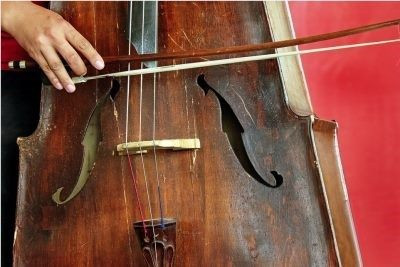Breaking With Tradition
Yes, you can teach an old dog(house) new tricks.
We are very fortunate to play an instrument with a long, proud tradition. From its beginnings in (most estimate) 17th century Europe, to the more manageable, modern basses we play today, those of us whom the bass has chosen have a rich legacy to live up to. So it's natural to feel like we ought to to stick to certain historical and traditional conventions that we take for granted.
But sometimes it pays to think "outside the box." For instance, the subsequent development of the overwound gut string -- improving the tone, pitch, and playability of the erewhile
massively thick low strings used up to that point -- quite likely saved the double bass from extinction. Until those string improvements came along, the instrument was very large and rather difficult to play -- and the indistinct pitch and tone of the low notes usually relegated it to simply doubling the cello line an octave down (hmmmm... "Doublebass?").
This improvement in strings alone provided access to much better-sounding lower notes, while also allowing the instrument itself to be downsized to its more practical and comfortable current dimensions. (Did you ever wonder why our modern "regular sized" basses are actually considered 3/4 size? Now you know.) Those innovations helped to evolve the bass into a legitimate instrument of its own standing.
Lots of other mini-revolutions have come along as well -- the development of steel and synthetic-based strings; less costly laminated construction techniques; useful modifications like E-string extensions and tunable afterlength tailpieces; the advent of amplification using specialized pickups and amplifiers... the list can go on forever, I'd think. We've come to a new renaissance of sorts, with all kinds of new products for the upright bass being introduced all the time. From unconventional pickups like the
Ehrlund EAP Linear Microphone, to amps like the stunning DoubleShot speakers and combos, there are plenty of revolutionary products in high-end amplification.
But there are even some innovations that are more "ground level" -- things on the instrument itself -- that can be reimagined, and possibly improved. For instance, the lovely handmade
Nino Mutes for upright and electric upright basses have a whole new approach to altering the tone of your instrument. And the clever Hipshot Freerange Extender offers a temporary alternative to a costly, permanent E-extension.
As always, thanks for visiting, and if you come across any innovative bass thinking we should know about,
let us know!
It pays to read to the end: If you enjoyed this article, feel free to use coupon code
FREECARABINER to get one of our sweet new Carabiner Keychains FREE with an order of $10 or more, through the end of March (2021).
Recent Posts
-
Pirastro's Perpetual Bass Strings - Do I want Stark, Medium, or some combination?
I just spent the time writing this up to post in a thread at Talkbass, so I figured I'd also share i …Nov 12th 2025 -
Preserving our Humanity
Our site has a very distinctive style and flow. And that comes from our longtime dedication to being …Sep 3rd 2025 -
What can Brown do for you? Nothing good, at least lately.
I really don't think I've ever publicly called out any other companies, so this is a first. But I've …Aug 13th 2025




